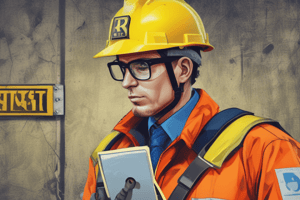Podcast
Questions and Answers
What percentage of accidents are considered unavoidable according to Heinrich's theory?
What percentage of accidents are considered unavoidable according to Heinrich's theory?
- 88%
- 5%
- 10%
- 2% (correct)
Which of the following best describes the Multiple Cause Theory of accidents?
Which of the following best describes the Multiple Cause Theory of accidents?
- Accidents result from a series of random or unrelated actions. (correct)
- Accidents are solely due to human error.
- Preventing one incident guarantees future safety.
- Accidents are caused by a specific single event.
What is the primary focus of System Analysis in accident investigation?
What is the primary focus of System Analysis in accident investigation?
- Examining surface causes of the accident.
- Determining root causes of the accident. (correct)
- Analyzing unsafe behaviors.
- Identifying hazardous conditions.
Which of the following components is NOT a part of the system design root causes?
Which of the following components is NOT a part of the system design root causes?
What is the significance of the '6-Ps' in safety management systems?
What is the significance of the '6-Ps' in safety management systems?
What is the purpose of marking materials, tools, or equipment during an accident investigation?
What is the purpose of marking materials, tools, or equipment during an accident investigation?
Which method is useful for pinpointing the exact location of an object during an investigation?
Which method is useful for pinpointing the exact location of an object during an investigation?
What should be prioritized when conducting witness interviews after an accident?
What should be prioritized when conducting witness interviews after an accident?
What is the formula for calculating Total Case Incident Rates (TCIR)?
What is the formula for calculating Total Case Incident Rates (TCIR)?
Which of the following would NOT be considered a direct cost following an accident?
Which of the following would NOT be considered a direct cost following an accident?
What do hidden costs in an accident typically include?
What do hidden costs in an accident typically include?
What defines a special accident investigation?
What defines a special accident investigation?
Which of the following is included in the Hidden Costs Associated with Incidents?
Which of the following is included in the Hidden Costs Associated with Incidents?
Which of the following is NOT one of the 'Construction Fatal 4' accident types?
Which of the following is NOT one of the 'Construction Fatal 4' accident types?
What must an employer do when an OSHA compliance officer conducts an inspection?
What must an employer do when an OSHA compliance officer conducts an inspection?
Which of the following is NOT a priority for OSHA inspections?
Which of the following is NOT a priority for OSHA inspections?
What is the penalty for a serious violation of OSHA regulations?
What is the penalty for a serious violation of OSHA regulations?
What must an employer do with an OSHA citation once received?
What must an employer do with an OSHA citation once received?
What is considered a ‘Willful Violation’ under OSHA?
What is considered a ‘Willful Violation’ under OSHA?
What happens if an employer does not allow timely admission to the compliance officer?
What happens if an employer does not allow timely admission to the compliance officer?
Which type of violation can result in a daily penalty for failure to abate?
Which type of violation can result in a daily penalty for failure to abate?
What is the minimum retention period for Noise Exposure measurement records?
What is the minimum retention period for Noise Exposure measurement records?
What must be documented and dated as part of the management of change procedures?
What must be documented and dated as part of the management of change procedures?
How long should Bloodborne Pathogens monitoring-vaccination records be retained?
How long should Bloodborne Pathogens monitoring-vaccination records be retained?
When should employees and contractors receive training on changes affecting their job tasks?
When should employees and contractors receive training on changes affecting their job tasks?
What is the recommended retention period for general training records?
What is the recommended retention period for general training records?
Which of the following items is NOT mentioned as part of the management of change procedures?
Which of the following items is NOT mentioned as part of the management of change procedures?
What is the retention requirement for Permit-Required Confined Spaces records?
What is the retention requirement for Permit-Required Confined Spaces records?
How long must the OSHA300 log and 300A records be retained?
How long must the OSHA300 log and 300A records be retained?
Which documentation should be kept until the employee is no longer employed?
Which documentation should be kept until the employee is no longer employed?
What represents the underlying cause of an accident in safety management?
What represents the underlying cause of an accident in safety management?
What constitutes a recordable injury or illness for an employer?
What constitutes a recordable injury or illness for an employer?
Which of the following is NOT a benefit of a strong safety culture?
Which of the following is NOT a benefit of a strong safety culture?
What is the primary role of management in fostering a safety culture?
What is the primary role of management in fostering a safety culture?
What differentiates safety objectives from general safety goals?
What differentiates safety objectives from general safety goals?
Which of these actions would be classified as a reinforcer?
Which of these actions would be classified as a reinforcer?
Which option best defines the term 'accountability' in the context of workplace safety?
Which option best defines the term 'accountability' in the context of workplace safety?
What is one of the stated general goals for a construction safety program?
What is one of the stated general goals for a construction safety program?
Which statement is true regarding the frequency of at-risk behaviors in companies with a strong safety culture?
Which statement is true regarding the frequency of at-risk behaviors in companies with a strong safety culture?
How can the success of a company's Construction Safety Management System (CSMS) be influenced?
How can the success of a company's Construction Safety Management System (CSMS) be influenced?
What should be the outcome of understanding the benefits of safety practices in a company?
What should be the outcome of understanding the benefits of safety practices in a company?
Flashcards
Imminent Danger Inspection
Imminent Danger Inspection
An OSHA inspection where a workplace is checked for imminent dangers to workers.
Catastrophe/Fatal Accident Inspection
Catastrophe/Fatal Accident Inspection
An OSHA inspection triggered by an accident or fatality at a workplace, like a serious accident.
Employee Complaint Inspection
Employee Complaint Inspection
An OSHA inspection based on a complaint made by an employee regarding safety concerns.
Programmed High-Hazard Inspection
Programmed High-Hazard Inspection
Signup and view all the flashcards
Follow-Up Inspection
Follow-Up Inspection
Signup and view all the flashcards
Other-Than-Serious Violation
Other-Than-Serious Violation
Signup and view all the flashcards
Serious Violation
Serious Violation
Signup and view all the flashcards
Accident Investigation
Accident Investigation
Signup and view all the flashcards
Triangulation Method
Triangulation Method
Signup and view all the flashcards
Interviewing Records
Interviewing Records
Signup and view all the flashcards
Chain of Custody
Chain of Custody
Signup and view all the flashcards
Total Case Incident Rate (TCIR)
Total Case Incident Rate (TCIR)
Signup and view all the flashcards
Severity Rate
Severity Rate
Signup and view all the flashcards
Direct Costs
Direct Costs
Signup and view all the flashcards
Hidden Costs
Hidden Costs
Signup and view all the flashcards
Construction Fatal 4
Construction Fatal 4
Signup and view all the flashcards
Management of Change
Management of Change
Signup and view all the flashcards
Technical Basis for Change
Technical Basis for Change
Signup and view all the flashcards
Impact on Safety, Health, and Environment
Impact on Safety, Health, and Environment
Signup and view all the flashcards
Time Period for Implementation
Time Period for Implementation
Signup and view all the flashcards
Management Approval Procedures
Management Approval Procedures
Signup and view all the flashcards
Documentation and Dating of Changes
Documentation and Dating of Changes
Signup and view all the flashcards
Training for Affected Employees
Training for Affected Employees
Signup and view all the flashcards
Accident Analysis
Accident Analysis
Signup and view all the flashcards
Surface Causes
Surface Causes
Signup and view all the flashcards
Root Causes
Root Causes
Signup and view all the flashcards
Recordable Injury/Illness
Recordable Injury/Illness
Signup and view all the flashcards
Safety Culture
Safety Culture
Signup and view all the flashcards
Management Commitment to Safety
Management Commitment to Safety
Signup and view all the flashcards
Accountability
Accountability
Signup and view all the flashcards
Safety Objectives
Safety Objectives
Signup and view all the flashcards
Reinforcers
Reinforcers
Signup and view all the flashcards
Punishers
Punishers
Signup and view all the flashcards
Benefits of a Strong Safety Culture
Benefits of a Strong Safety Culture
Signup and view all the flashcards
Importance of Goals and Objectives
Importance of Goals and Objectives
Signup and view all the flashcards
Safety Culture and Accident Reduction
Safety Culture and Accident Reduction
Signup and view all the flashcards
Domino Theory of Accidents
Domino Theory of Accidents
Signup and view all the flashcards
Heinrich's Domino Theory
Heinrich's Domino Theory
Signup and view all the flashcards
Accident/Incident Theory
Accident/Incident Theory
Signup and view all the flashcards
System Weaknesses
System Weaknesses
Signup and view all the flashcards
Multiple Cause Theory
Multiple Cause Theory
Signup and view all the flashcards
Study Notes
OSHA (Occupational Safety and Health Administration)
- Created within the Department of Labor
- Primary responsibilities:
- Encourage employers and employees to reduce workplace hazards and implement improved safety standards
- Conduct research in occupational safety and health and develop innovative solutions to problems
- Establish separate but dependent responsibilities and rights for employers and employees
- Maintain reporting and record-keeping systems for injuries and illnesses, facilitating training programs for qualified personnel
- Develop mandatory safety and health standards and enforce them effectively
OSHA Coverage
- Covers all private sector employers with one or more workers in all 50 states and U.S. territories
- Excludes:
- Public sector employers (federal, state, local government)
- Self-employed individuals
- Family members operating a farm
- Domestic household workers
OSHA Inspections
- OSHA inspections require a warrant to enter a workplace, per Marshall vs Barlow
- Inspections prioritize: imminent dangers, catastrophes, employee complaints, and programmed high-hazard inspections
OSHA Citation Penalties
| Type of Violation | Penalty |
|---|---|
| Serious | $15,625 per violation |
| Other-Than-Serious | $15,625 per day beyond the abatement date |
| Posting Requirements | $15,625 per violation |
| Failure to Abate | $156,259 per violation |
| Willful or Repeated | $156,259 per violation |
Employer Rights and Responsibilities
- Examine workplace conditions for compliance with standards.
- Minimize hazards.
- Use warning systems (color codes, posters, labels, signs).
- Provide training per standards.
- Keep required records.
- Provide access to employee medical records.
Employee Rights and Responsibilities
- Read OSHA poster
- Follow employer safety rules and wear required gear and equipment.
- Follow safe work practices.
- Report hazards to supervisor/safety committee, or OSHA if not fixed.
OSHA Recordkeeping
- Employers must keep records of work-related fatalities, injuries, and illnesses.
Studying That Suits You
Use AI to generate personalized quizzes and flashcards to suit your learning preferences.




